By Satoshi Kawakami1,5*, Yoshimu Tanaka2, Sota Doiyama3, Mizuki Murakami3, Tomoya Takeda3, Kiichiro Mochida4, Takashi Nakamura3, Yoshitaka Fukuzawa5
1Department of Nutrition, Faculty of Health Care, Kiryu University, Gunma 379-2392, Japan
2Tanaka Clinic, Osaka 544-0024, Japan
3Research and Development Department, Asai Germanium Research Institute Co., Ltd.; Kanagawa 215-0004, Japan
4Research and Development Department, RCT Japan Co., Ltd.; Tokyo 150-0002, Japan
5Aichi Medical Preemptive and Integrative Medicine Center (AMPIMEC), Aichi 480-1195, Japan
*Corresponding author: Satoshi Kawakami, Department of Nutrition, Faculty of Health Care, Kiryu University, Gunma 379-2392, Japan.
Published Date: February 20, 2025
Citation: Kawakami S, Tanaka Y, Doiyama S, Murakami M, Takeda T, et al. (2025) A Study to Examine the Effect of Ingesting Processed Foods Containing the Organogermanium Compound “Asaigermanium: poly-trans-[(2-Carboxyethylgerma) Sesquioxane]” on Human Immune Function. Curr Res Cmpl Alt Med 9: 263. https://doi.org/10.29011/2577-2201.100263
Abstract
Lifestyle-related diseases can be said to be chronic inflammation. Among lifestyle-related diseases, there are vascular diseases such as cancer, and all of them are thought to be caused by chronic inflammation. It is said that in addition to triglycerides, the immune system is deeply involved in these lifestyle-related diseases. If lifestyle-related diseases can be prevented, it is thought that not only average life expectancy but also healthy life expectancy will be extended. Therefore, it is usually attempted to improve the condition by forcibly intervening through exercise and dietary restrictions, but the intervention itself can become stressful and homeostasis may not be maintained. The key points here are triglycerides (TG) and the immune system. From the perspective of the risk of arteriosclerosis, it is necessary to lower the value of triglycerides. At the same time, it is not enough to strengthen the immune system. In general, if the immune system is strengthened too much, it may cause negative effects on the body, such as autoimmune diseases and collagen diseases, so it is necessary to adjust it. In this study, we looked at changes in triglyceride levels and the immune system when consuming processed foods containing “Asaigermanium: poly-trans-[(2-carboxyethylgerma) sesquioxane],” and found that triglyceride levels were significantly reduced without any intervention such as exercise. In addition, when various biomarkers were measured from a multifaceted perspective regarding the immune system, it was suggested that the immune system may be regulated. This study has provided interesting data showing that consuming Asaigermanium reduces the risk of lifestyle-related diseases and regulates immune function, which we report here.
Introduction
The number of deaths from lifestyle-related diseases is increasing year by year [1]. In Japan, the death rate from old age has been increasing recently, but cancer, heart disease, and cerebrovascular disease remain among the leading causes of death [2]. Preventing these diseases is considered to be an important factor in extending average and healthy lifespan [3]. In particular, the leading cause of death in Japan is malignant neoplasms, which are closely related to immunity [4]. Normally, even in situations where cancer has not been diagnosed, cancer cells develop in our bodies due to errors in gene replication [5]. However, immune cells, mainly NK cells and macrophages, are able to attack and kill very early cancers, so they do not develop [6]. However, with aging, the function of immune cells is weakened or their absolute number decreases [7], and cancer develops because they are unable to suppress cancer cells.
Moreover, in recent years, it has been discovered that chronic mild inflammation is induced in the cancer microenvironment. In other words, it can be said that the onset of cancer is deeply related to chronic inflammation [8]. In diseases other than cancer, it is known that the values of inflammatory cytokines such as IL-1β and IL-6 are high in hypertension, arteriosclerosis, cardiovascular disease, etc., and it is considered very important to focus on the function of the immune system in preventing lifestyle-related diseases taking these into consideration [9].
Regarding immunity, people are still very interested in it, partly due to the influence of COVID-19. As a result, the consumption of functional foods has been increasing in Japan to maintain immune function and prevent lifestyle-related diseases including cancer. The organogermanium compound poly-trans-[(2-carboxyethylgerma) sesquioxane] (Ge-132) is one of the functional food ingredients that have been attracting attention recently. This compound was discovered by Mironov et al. while synthesizing other organogermanium compounds. Kakimoto and Oikawa synthesized this poly-trans-[(2-carboxyethylgerma) sesquioxane] from metallic germanium in 1967 and worked on mass production. Currently, this organogermanium compound is known as “Asaigermanium” and has been used to this day as a substance that suppresses inflammation and pain. Normally, it is a powder (polymer) in which Ge atoms and O atoms are alternately bonded to form a 12-membered ring (Figure. 1 (A)), but when hydrolyzed in an aqueous solution, it becomes (3-trihydroxygermyl) propanoic acid (THGP) (Figure. 1 (B)). The physiological function of this molecule in suppressing inflammation and pain by interacting with various molecules in the body has been elucidated and reported (see below).
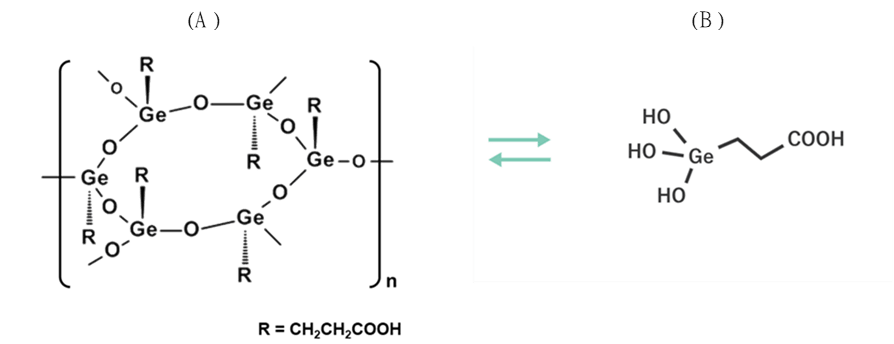
Organogermanium is now widely known and widely distributed as a dietary supplement, but in the past, various health problems were reported due to long-term intake of foods containing toxic inorganic germanium. Specifically, renal dysfunction, renal tubular degeneration, anemia, and muscle weakness were confirmed [10]. This led to the misconception that organic germanium, including Ge-132, is also toxic. However, these adverse events were reported and concluded by Sanai et al. to be caused by inorganic germanium “germanium dioxide (GeO2)” and that Asaigermanium is organic germanium “Ge-132: (GeCH2CH2COOH)2O3” [11,12].
In addition, organic germanium, especially Asaigermanium, has a history of being used in pharmaceutical development, and its high safety has been confirmed by safety tests conducted under GLP standards [13]. Furthermore, in 2019, it was the first organic germanium, as well as the first fully chemically synthesized product, to be certified and registered under the “Voluntary Safety Inspection Certification and Registration System for Health Foods” run by the Japan Health and Nutrition Food Association, a public interest incorporated foundation.
The wide range of physiological effects of Asaigermanium are thought to be brought about by the interaction of THGP with biomolecules. For example, by forming complexes with L-DOPA, ATP, adrenaline, etc., it has been reported that it inhibits melanin production [14], suppresses pain [15,16], and has anti-inflammatory effects [17]. In addition, there are reports of immune activation, such as activation of natural killer (NK) cells and macrophages, in pilot studies, cell and animal experiments [18,19]. In particular, it has been reported recently that Asaigermanium promotes the differentiation of M1 macrophages, which are highly aggressive against cancer [20]. On the other hand, there are also research reports that administration of Asaigermanium was useful for patients with rheumatoid arthritis, an autoimmune disease [21]. In general, rheumatoid arthritis is a disease that occurs when an excessive immune response is triggered and the self is recognized as non-self. The fact that it was effective against rheumatoid arthritis suggests that Asaigermanium not only has an immune “activating” effect, but also a “regulating” effect that puts the brakes on excessive immunity. Therefore, this time we focused on the immune system, formulated the hypothesis that “Asaigermanium has not only an immunostimulatory effect but also an immunomodulatory effect,” and conducted a pilot study.
Material and Methods
Type of research
Functionality evaluation through open study
Subjects and bias approach
The study was conducted in Osaka, Japan, from October to November 2022. The subjects were healthy men and women aged 40 to 69 years old with no underlying diseases and a history of receiving the SARS-CoV-2 mRNA vaccine, and six men and women who applied were set as subjects for this study. The reason for setting the age was that the incidence of lifestyle-related diseases increases from the age of 40, so the above people were targeted from the perspective of observing the adjustment of the immune system. In addition, since vaccination with the mRNA vaccine is strongly recommended at this time and it is an event that also has an effect on the immune system, people with a history of vaccination were set as subjects.
Intervention method
Healthy subjects without underlying diseases and not taking any medicines were selected from the subjects who applied for this study. From among them, 12 people (6 men and 6 women) who gave their consent were selected as subjects. In an oven study, the subjects took 4 capsules/day (each capsule containing 250 mg of Asaigermanium) of a processed food containing only organic germanium (Asaigermanium S) after breakfast. The administration period was 4 weeks, and general blood tests, urine tests, QOL questionnaires, and saliva TAQ tests (Tokyo Mibyo Center Co., Ltd. Tokyo, Japan) were conducted before and after 4 weeks of drinking, and the evaluation items shown in the following section were measured.
Evaluation items
Blood test.
1. Interferon-gamma (IFN-γ)
2. NK Cells
3. Treg
4. NKT Cells
5. TG
Peripheral blood was collected from the subjects before and 4 weeks after ingestion of the test food. The collected blood was centrifuged and separated into blood cell fractions, and the lymphocyte fraction was analyzed by flow cytometry at IMUH Co., Ltd. The method used was in accordance with the general FACS analysis method.
In addition, general blood tests were performed to measure peripheral blood (WBC, WBC fraction, RBC, Hb, Ht, PLT), liver function (AST, ALT, γ-GTP, ALP, LDH), renal function (Cre, BUN, UA, eGFR), lipids (T-CHOL, HDL, LDL, TG, CPK), Ca, Mg, P, Fe, ferritin, high-sensitivity CRP, blood glucose, HbA1c, protein fractions (ALB, α1-G, α2-G, β-G, γ-G), immunoglobulins (IgA, IgG, IgM, IgE), thyroid function (TSH, FT4, FT3), and 25(OH)V-D3.
Salivary mRNA expression level test (TAQ test)
TAQ test is an abbreviation of Telomerase Activity Quantification, and is a method to measure the expression level of cancer-related genes using collected saliva to evaluate cancer risk and immune function. This test carried out the “TAQ Standard” provided by Tokyo Mibyo Center Co., Ltd., which measures mRNA related to cancer risk, immune function, and anti-aging, and measured the following seven items.
1. CD68
2. CD8a
3. CD8b
4. CD4
5. Colony Stimulating Factor 1 Receptor (CSF1R)
6. Interferon-Gamma (IFN-γ)
7. Human Telomerase Reverse Transcriptase (hTERT)
Checking for changes in symptoms and the occurrence of side effects using a QOL questionnaire
The QOL questionnaire was used to ask the participants the following 10 questions, which were then scored for evaluation.
1. Do you feel that your memory has deteriorated recently.
2. Do you feel that your physical strength has declined.
3. Do you feel that the food tastes good.
4. Have you been sleeping well.
5. Feel anxious.
6. Do you feel that your concentration has decreased.
7. There is hope in life.
8. You feel that you have no energy.
9. Are you able to become passionate about something.
10. How is your overall physical condition.
There were also sections in which participants could freely write about their symptoms, etc.
Check for adverse reactions
Urine tests were performed to check for urinary protein, sugar, occult blood, urobilinogen, ketone bodies, and pH.
Statistical analysis
In statistical processing, the normality of the data was first tested using the Shapiro-Wilk normality test. For items that were confirmed to be normally distributed, a paired t-test was performed, and for items that were not confirmed to be normally distributed, a Wilcoxon rank sum test was performed. Analysis was performed using IBM SPSS Statistics (Ver. 25). The significance level was set at 5%.
Ethical considerations
This study received ethical approval from the Japan Society of Clinical Study for Frontier-Medicine (JSCSF). Ethics review number: IRB20220724-08
Results
General blood tests
In this study, no abnormalities were observed in general biochemical tests (lipids, liver function, kidney function, etc.) due to the ingestion of the test substance. In addition, no significant abnormalities were observed in inflammatory responses (CRP) or peripheral blood tests (white blood cells, red blood cells, platelets).
Comparison of immune function by ELISA and FACS
Interferon-gamma (IFN-γ)
IFN-γ is a protein that is transiently produced mainly by NK cells, T cells, and dendritic cells in response to antigen stimulation or microbial infection. In addition to enhancing antiviral activity, it has a variety of functionalities, including antitumor activity, cell proliferation inhibition, and macrophage and NK cell activation.
As shown in Table 1 and Figure 2(A), after 4 weeks of ingestion of the test food, IFN-γ significantly increased from 0.227±0.21 pg/ml to 0.400±0.26 pg/ml (p<0.05).
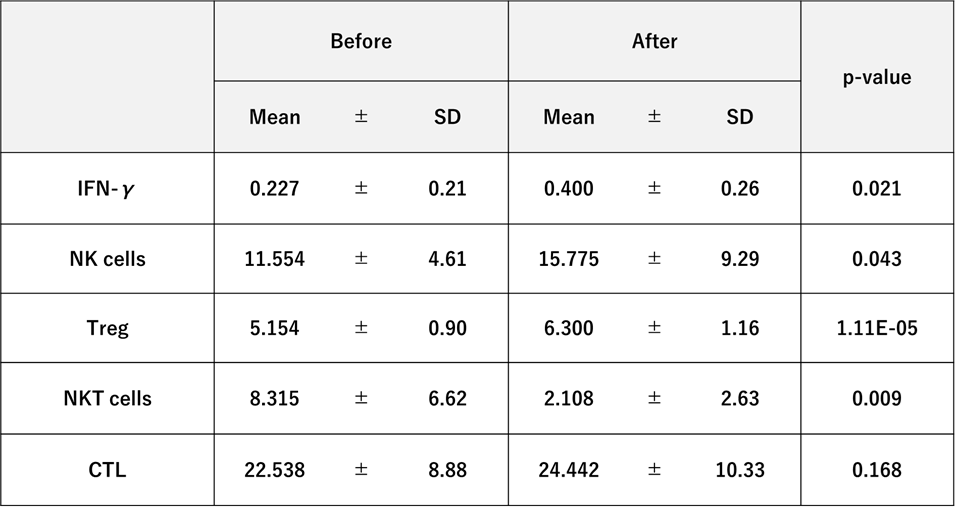
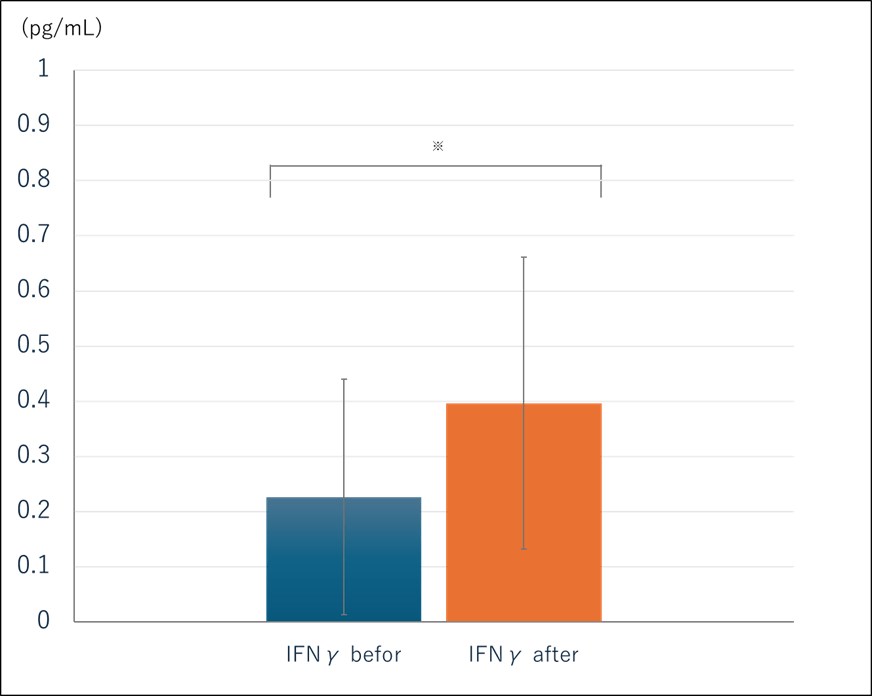
Natural Killer (NK) Cells
NK cells are lymphocyte cells that belong to the natural immune system and can kill cancer cells and virus-infected cells without being sensitized to antigens. It is said that NK activity decreases due to aging and unbalanced diet and is known to be closely related to lifestyle.
As shown in Table 1 and Figure 2(B), by consuming the test food for four weeks, the average activity increased significantly by about 1.4 times, from 11.554±4.61 to 15.775±9.29 (p<0.05). Furthermore, no clear differences were observed due to gender or age differences.
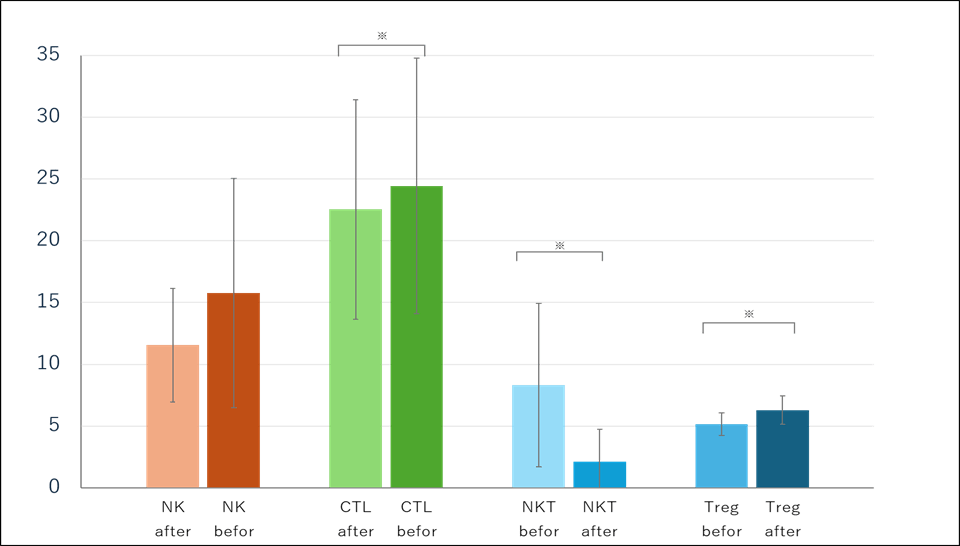
The time course of the mean value of interferon gamma (INF-γ), NK cell count, number of regulatory T cells (Tregs), the transition of the average value of natural killer T cell (NKT) number, and the transition of the mean value of the killer T cell (CTL) number.
The amount of IFN-γ was measured in blood by ELIZA’s method, and others were measured the proportion of each number of cells by FACS.
As for statistical analysis, a paired t-test was performed when normality was observed, and a Wilcoksen’s rank sum test was performed when normality was not observed. A significance level (p-value) of 0.05 was used, with “*” in the graph indicating p <0.05.
Regulatory T Cells (Treg)
Activation of immune function is important from the viewpoint of biological defense, but excessive immune response can cause autoimmune diseases and inflammatory diseases. Therefore, there are cells that act as brakes on immune function, and among them, regulatory T cells (Treg) are important cells that act as brakes on the immune system by producing IL-10, an anti-inflammatory cytokine. They are also present in visceral fat tissue, and there are reports that they are involved in insulin sensitivity and other factors due to their anti-inflammatory properties, and are thought to play an important role in lifestyle-related diseases.
As shown in Table 1 and Figure 2(B), administration of the test food significantly increased Treg activity by about 1.2 times, from 5.154±0.90 to 6.300±1.16 (p<0.05). In addition, no clear differences were observed due to gender or age differences.
Natural Killer T (NKT) Cells
NKT cells are immune cells that have both NK cell-like receptors and T cell-like receptors, and have properties intermediate between innate and adaptive immunity. In response to antigen presentation from dendritic cells, they not only directly attack foreign substances, but also produce immune response substances such as various cytokines such as IFN-γ and chemokines. There are also reports that NKT cell activity can be induced by diet, environmental factors, intestinal flora, etc., so they were the subject of analysis in this study.
As a result of 4 weeks of intake of the test food, as shown in Table 1 and Figure 2(B), a significant decrease in the average activity of NKT cells was observed, from 8.315±6.62 to 2.108±2.63 (p<0.05). Furthermore, no clear differences were observed due to gender or age differences.
Cytotoxic T Cells (CTL)
Cytotoxic T cells (CTLs) are cells responsible for adaptive immunity, directly attacking microbial-infected cells and cancer cells, leading to the death of the targeted cells.
As shown in Table 1 and Figure 2(B), after 4 weeks of ingesting the test food, no significant changes were observed before and after ingestion.
Triglyceride (TG)
Triglyceride (TG) are an important source of energy and have various functions, such as helping with vitamin absorption. On the other hand, excessive intake is known to lead to obesity and increase the risk of myocardial infarction. In addition, it can cause poor blood flow and arteriosclerosis, and it is possible that the presence of large amounts of triglycerides in the body can suppress the function of immune cells due to poor blood flow. In addition, as mentioned above, obesity is also involved in the induction of inflammation when accumulated in large amounts in adipose tissue, so it is thought to be deeply related to the immune system. Therefore, reducing the amount of triglycerides in the blood is thought to affect the regulation of immune function.
After 4 weeks of intake of the test food, as shown in Table 2 and Figure 3, the average TG amount tended to decrease from 159.33 ± 89.82 to 123.92 ± 46.17 (p = 0.072).

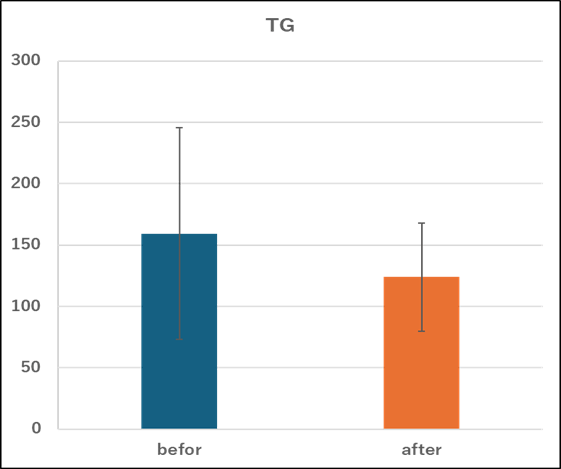
A graph showing changes in triglyceride levels in peripheral blood before and after intake of the test food.
Error bars indicate standard deviation (SD). A paired t-test was performed for statistical analysis.
Comparison of mRNA expression analyses by TAQ assay
This test method (Telomerase Activity Quantification) is a method for simultaneously analyzing the expression of mRNA in saliva, and although it is not yet clear whether it completely reflects the internal state of the body, it was used as a simple test method to quantify the expression of telomerase activity 3.4.7 as a risk assessment for immune expression and cancer, which is the purpose of this test. 3.4.1 to 3.4.6 are provided as reference data.
Cluster of Differentiation (CD) 68
CD68 is a 110 kDa membrane glycoprotein that is widely expressed in monocytes and macrophage cells in humans. It is said to be related to the phagocytic activity of macrophages, and it is thought that by measuring its expression level, it is possible to examine whether the activity of monocytes and macrophages is increased. In this study, we measured the mRNA expression level in saliva.
As shown in Table 3 and Figure 4(A), the expression level was significantly reduced by approximately 0.7-fold, from 1.217±0.54 to 0.825±0.36, after 4 weeks of ingestion of the test substance (p<0.05).
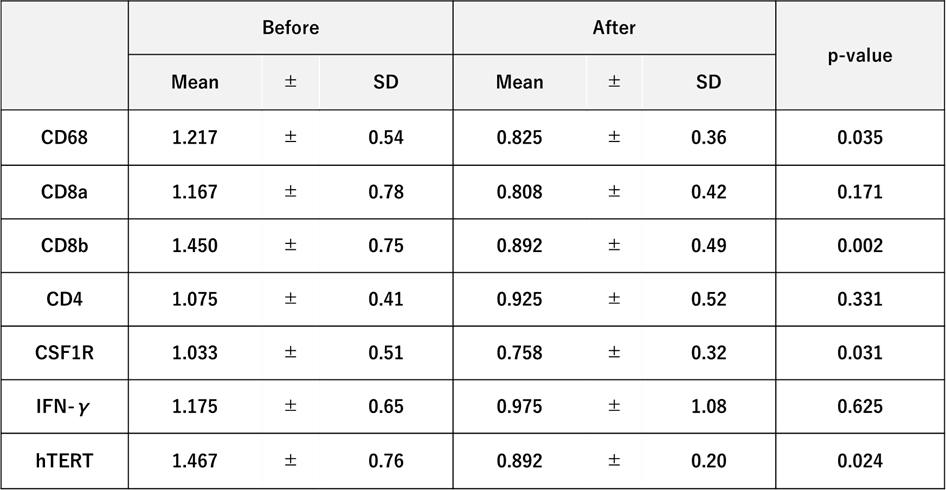
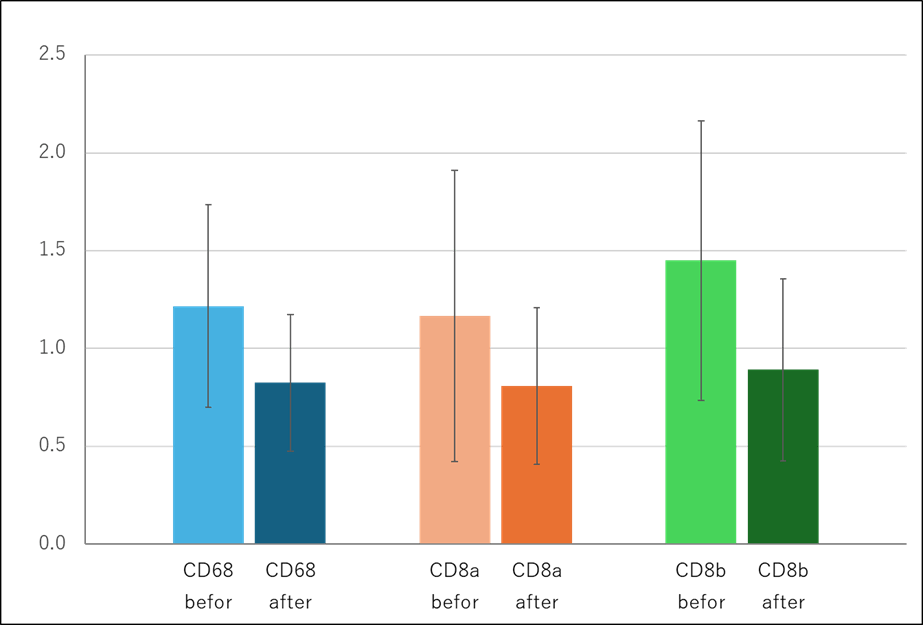
CD8a
CD8a is a transmembrane glycoprotein expressed on the surface of cytotoxic T cells, NK cells, and dendritic cells. CD8a is one of the molecular chains that make up the CD8 dimer expressed on cytotoxic T cells. It is believed that the activity of cytotoxic T cells and NK cells can be examined by looking at the amount of expression. In this study, the amount of mRNA in saliva was measured.
After 4 weeks of ingestion of the test food, the expression level decreased by about 0.7-fold, from 1.167±0.78 to 0.808±0.42, but no significant difference was observed (Table 3, Figure 4(A)).
CD8b
CD8b and CD8a form a CD8 dimer. It is believed that by examining the expression levels of CD8b, together with CD8a, it is possible to examine the activity of cytotoxic T cells and NK cells. In this study, the amount of mRNA in saliva was measured.
As a result, after 4 weeks of ingestion of the test food, the expression level significantly decreased from 1.450±0.75 to 0.892±0.49, approximately 0.83 times higher (Table 3, Figure 4(A), p<0.05).
CD4
CD4 is a glycoprotein expressed on the surface of monocytes, dendritic cells, and other cells, mainly helper T cells, and is a type of cell surface antigen. High expression of CD4 is thought to indicate that helper T cells in particular are activated.
As a result, after 4 weeks of ingestion of the test food, CD4 expression changed from 1.075±0.41 to 0.925±0.52, approximately 0.86 times higher, but no significant difference was observed (Table 3, Figure 4(B)).
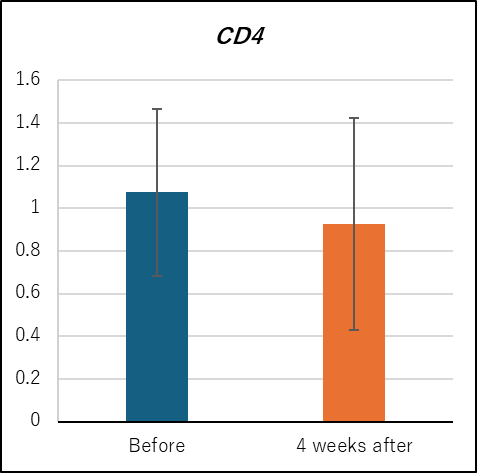
Colony Stimulating Factor-1 Receptor (CSF1R) Average
It is a receptor for Colony Stimulating Factor-1 (CSF1) and is present on the cell membrane. It is believed that CSF1-CSF1R signaling is involved in the survival, differentiation, and proliferation of macrophage-lineage cells involved in immunity.
As a result, a significant decrease in expression level was observed after 4 weeks of ingestion of the test food, from 1.033±0.51 to 0.758±0.32, approximately 0.73 times the original level (Table 3, Figure 4(C), p<0.05).
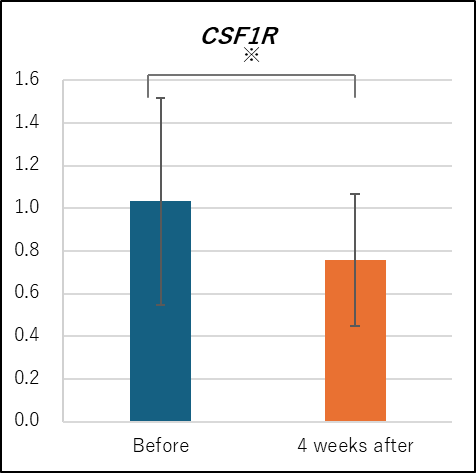
IFN-γ Average
IFN-γ is a cytokine secreted mainly by T cells and NK cells, and has the effect of enhancing inflammation caused by white blood cells. In this study, the amount of mRNA in saliva was measured.
As a result, after 4 weeks of ingestion of the test food, its expression level changed from 1.175±0.65 to 0.975±1.08, approximately 0.83 times higher, but no significant decrease in the expression level was observed (Table 3, Figure 4(D)). This result differed from the results of analysis by ELISA.
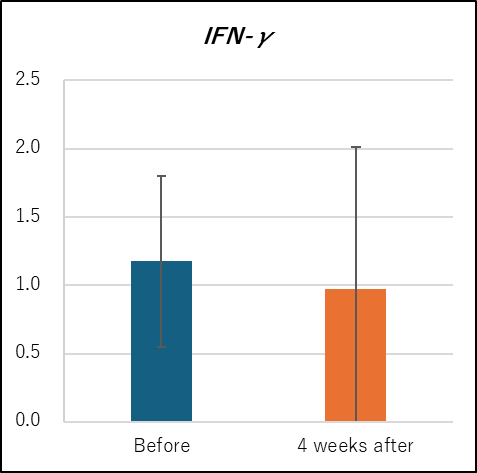
hTERT Average
hTERT is a telomerase reverse transcriptase known to be involved in the development and proliferation of cancer. In this study, the amount of mRNA in saliva was measured.
As a result, a significant decrease in expression level was observed after 4 weeks of ingestion of the test food, from 1.467±0.76 to 0.892±0.20, approximately 0.61 times the original level (Table 3, Figure 4(E), p<0.05).
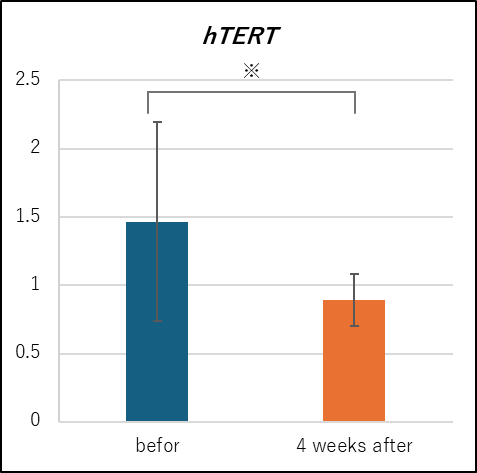
Saliva was collected from subjects, and immune-related mRNA was measured by the TAQ test.
(A) shows the expression level of CD68 and CD8a and CD8b.
(B) shows the expression level of CD4.
(C) shows the expression level of IFN-γ.
(D) represents the expression level of CSF1R.
(E) shows the expression level of hTERT.
As for statistical analysis, a paired t-test was performed when normality was observed, and a Wilcoxon’s rank sum test was performed when normality was not observed.
A significance level (p-value) of 0.05 was used, with “*” in the graph indicating p <0.05.
QOL Questionnaire
In this study, 5 people had an improvement in total score (the higher the score, the greater the improvement) before and after taking the test food, 5 people had a worsening effect, and 2 people had no change. Regarding overall physical condition, 4 people had an improvement, 3 people had a worsening effect, and 5 people had no change.
Confirmation of adverse reactions by urine test
Only one subject showed abnormalities, such as urinary protein (2+), but there was no significant change in renal function. No other significant abnormalities were observed in the urine test.
Discussion
As a result of this study, no changes in clinical symptoms, urine, or general blood tests that could be considered side effects were observed. The recommended daily intake of Asaigermanium is 500 mg, but in this study, twice that amount, 1000 mg, was used. Based on the results of this study, it was determined that taking 1000 mg of Asaigermanium during the 4-week observation period is safe for the human body.
FACS analysis showed that the test substance increased the number of NK cells and Treg cells in the blood. Furthermore, a significant increase in IFN-γ was observed with the intake of the test substance. In previous studies of the effects of Asaigermanium on the immune system, the activation of NK cells and the induction of IFN-γ in the blood have been confirmed and reported in many cases. This study also confirmed that there was a statistically significant increase. On the other hand, a completely new finding was that the number of NKT cells was significantly suppressed. Furthermore, in the measurement of salivary mRNA by the TAQ test, the test substance showed a decrease in the expression of hTERT, an indicator of cancer. However, the expression of membrane proteins and IFN-γ, indicators of each immune cell, was decreased or showed no significant change. mRNA is very easily degraded, and samples in an environment where a large amount of RNase is present are not suitable for normal quantification. In that sense, we consider the data other than the data on telomerase activity, which is the original purpose of the TAQ test, that is, the expression of hTERT (the correlation of which has been made clear from past research), to be reference values. In a broad sense, it may reflect the overview of gene expression in the oral cavity at the time of sample collection.
Although the data are obtained under such circumstances, the result of the decrease in the expression of IFN-γ in the TAQ test, which is secreted and present in saliva, was different from the FACS analysis, but since the amount of Treg increased, it is possible that a negative feedback mechanism was at work and gene expression was decreased.
While an increase in immune cells in peripheral blood was observed, the suppression of immune function was also observed, suggesting that the test substance may not only be involved in activating immune function, but also in suppressing immune function via Tregs, and thus may play a role in adjusting the balance of immune function.
If the immune system is too strong, it can cause inflammation and allergies [22], and if it is suppressed, it can cause the breakdown of homeostasis in the body, such as the trigger for carcinogenesis [23] or the onset of infectious diseases [24]. Therefore, it is thought that the immune system needs to be regulated [25]. Some substances that enhance the immune system, especially health foods, release cytokines when ingested and exert their effects [26], but substances that suppress the immune system are often substances that have adverse effects on the body [27] and may lead to the breakdown of the immune system. Therefore, it is considered to be a very significant result that the test substance acts to suppress the immune system without excessively enhancing it. Below is a discussion of each measurement item.
NK Cells
NK cells are lymphocytes that belong to the innate immune system and destroy cancer cells and virus-infected cells [28]. They are particularly effective against cancer cells [29]. In this study, the number of NK cells, which are considered to be the center of the innate immune system, increased significantly, which is thought to enhance the effectiveness of recognizing, attacking, and eliminating cancer cells and virus-infected cells. NK cells are also known to be activated in the intestinal Peyer’s patches and bone marrow [30]. In this study, the test substance was administered orally, so it was possible that NK cells were activated by stimulating the Peyer’s patches in the intestinal tract.
Previous basic and clinical studies on Asaigermanium (Ge-132) have also confirmed that oral intake induces activation of immune cells such as NK cells and macrophages within 24 hours in mice, dogs, and humans [18,19,31,32]. This study suggests that the number of NK cells can be increased even when the substance is taken in a normal, continuous amount.
Treg Cells
Treg cells are also known as regulatory T cells and have the function of suppressing immune responses [33]. They play a role in suppressing excessive immune responses that cause autoimmune diseases, inflammatory diseases, allergies, etc., and can therefore be said to be cells that regulate the immune system [34]. Tregs are also known to suppress the inhibition of naive T cell activity by reducing the expression of costimulatory molecules CD80/CD86 on the surface of dendritic cells through cytotoxic T-lymphocyte-associated protein 4 (CTLA-4) [35], to suppress the proliferation of effector T cells by consuming IL-2 [36], and to suppress the proliferation of effector T cells and the production of cytokines by producing IL-10 and adenosine [37], and are therefore thought to regulate the immune system. Therefore, this is considered to be a pivotal result in this study. Since a significant increase in Tregs was observed, it was suggested that the test substance may regulate the immune system, taking into account the changes in the number of NK cells and the changes in NKT cells described below. Previous research using Ge-132 has shown that administration increases the number of contrast suppressor T cells, which are thought to correspond to what we now call Tregs. This response is consistent with the results of previous basic research.
NKT Cells
NKT cells have the characteristics of both NK cells and T cells, and have the ability to enhance immune responses [38], directly attack cancer cells [39], and produce IFN-γ to activate the immune system [40]. Although NKT cells in peripheral blood are normally maintained at extremely low levels, it has been reported that when inflammation occurs, they migrate to the affected area and become highly abundant [41]. Considering the extremely high levels before the intake of the test food in this study and the background of the subjects, it is possible that the SARS-CoV-2 mRNA vaccine may have had some effect on NKT cells at some point (e.g., mild inflammation in the circulatory system, such as blood vessels and the heart). However, the number of NKT cells was significantly reduced by 4 weeks of intake of the test substance. This result suggests that the inflammatory response in the body was suppressed by the intake of the test substance. Alternatively, it is possible that the test substance acts on NKT cells via Tregs. In addition, the values after 4 weeks were also high in all subjects, and it is possible that inflammation that does not cause any clear physical discomfort (no subjective symptoms) remains in the vascular endothelium, etc. In some cases, the induction of NKT after vaccination may simply have returned to the original (original) low cell count over the course of one month, and Asaigermanium may not be involved.
Further investigation is required to determine whether this result is due to the increase in Treg count caused by Asaigermanium intake or whether it directly affects NKT cells, but since inflammation is an immune overreaction, it is suggested that this test substance may also have an immune regulating effect. Basic research for further evaluation is desired.
Triglyceride (TG)
Increased triglyceride is closely related to the promotion of plaque formation and may also lead to poor blood flow and arteriosclerosis [42]. Furthermore, increased triglyceride in the blood can decrease HDL cholesterol and increase LDL cholesterol [43]. Ultimately, the presence of a large amount of triglyceride can lead to dyslipidemia and lifestyle-related diseases [44]. At the same time, it has been pointed out that poor blood flow may weaken the immune system, so it is necessary to reduce excess triglyceride [45].
The test substance significantly reduced triglyceride levels, suggesting that it may be useful not only for regulating immune function but also for preventing lifestyle-related diseases. One of the authors, Nakamura et al., reported that oral intake of Ge-132 affects the excretion of bile acids through the induction of conjugation enzymes in bile components [46]. Since the absorption of triglyceride involves the formation of micelles with amphipathic molecules such as bile acids, increased excretion may have persistently decreased the uptake of triglyceride.
CD Group Average
CD68
CD68 is a 110 kDa membrane glycoprotein that is widely expressed on cells of monocyte and macrophage lineages [47], and its high expression is thought to enhance the activity of these lineages [48].
CD8a
CD8a is a transmembrane glycoprotein expressed on the surface of natural killer cells and dendritic cells. Although no significant difference was observed after administration of the test substance, a tendency toward a decrease was observed, suggesting that the substance may have suppressed excessive immune activity in oral mucosal tissues [49].
CD8b
CD8 is known as a cytotoxic T cell and expresses CD8b on its surface [50]. Since CD8b encodes a T cell surface glycoprotein, high expression levels are indicative of cytotoxic T cell activity. In this study, it is hypothesized that the significant decrease in CD8b may have been due to the ingestion of the test substance, which may have suppressed the activity of cytotoxic T cells. In other words, it may have suppressed the immune function from overreacting with Tregs [51].
CD8 is also a heterodimeric T cell surface glycoprotein consisting of CD8a and β chains [52]. It can identify cytotoxic/regulatory T cells that interact with targets bearing MHC class I [53]. CD8 is thought to play a role in the process of T cell-mediated cell death [54]. It is also hypothesized that the results show suppression of CD8 activity in conjunction with suppression of overreactions by Tregs.
CD4
CD4 is a glycoprotein expressed on the surface of helper T cells, as well as monocytes and dendritic cells, and is a type of cell surface antigen. High expression of CD4 is thought to indicate that helper T cells in particular are activated. As a decreasing trend was observed in this study, it is possible that it suppresses the excessive action of helper T cells. This suggests that it suppresses the release of excessive cytokines and regulates the immune system.
CSF1R
It is a receptor for colony-stimulating factor 1 (CSF1) and is present on the cell membrane. It is believed that CSF1-CSF1R signaling is involved in the survival, differentiation, and proliferation of immune-related macrophage lineage cells [55]. CSF1R is also an indicator of tumor-associated macrophage (TAM) activity, and high levels are said to increase the risk of TAM [56]. A significant decrease was observed in this study, suggesting that this could be an approach to cancer. In addition, a significant decrease was observed in hTERT, as described below, suggesting that this test substance has anti-carcinogenic and anti-cancer effects.
IFN-γ
IFN-γ is a cytokine secreted mainly by T cells and NK cells and has the effect of enhancing inflammation by leukocytes [57]. Although the results of this study showed a slight tendency for a decrease, the difference in SD was large, so this can be interpreted as indicating that there was almost no change.
hTERT
hTERT is a telomerase reverse transcriptase known to be involved in the development and proliferation of cancer [58]. The significant decrease in hTERT suggests that the test substance may have an inhibitory effect on the development and proliferation of cancer. Although the relationship between hTERT and cancer risk and its mechanism are not yet clear, hTERT has been shown to be clinically useful as a prognostic and predictive marker of cancer risk, so the decrease in hTERT levels using the test substance is considered to be a clinically significant result [59].
Conclusion
In this open study, various biomarkers were measured using this test substance. Ingestion of the test substance provided in this study for 4 weeks increased IFN-γ production and increased the amount of NK cells and Tregs. On the other hand, the amount of NKT cells was significantly decreased. It is known that the ratio of NKT cells per peripheral blood mononuclear cells is normally quite low (0.01-0.1%) [60], but the amount (ratio) of NKT cells before ingestion was high in the subjects in this study. Interestingly, the subjects in this study were vaccinated with the SARS-CoV-2 mRNA vaccine, and the Ministry of Health, Labor and Welfare has also disclosed that this vaccine has caused widespread side effects and serious adverse events. Based on this, we speculate that there may be some correlation between vaccination and increasing the normally low ratio of NKT cells. However, it was confirmed that the amount of NKT cells was significantly decreased by ingestion of the test substance. As mentioned above, we expect that either Asaigermanium, the main component of the test substance, acted suppressively on NKT cells, or acted suppressively via Treg, or that the inflammatory state that occurred after inoculation naturally decreased during the one-month test period. There have been many reports on the immunostimulatory effect of Asaigermanium, but the results of this study suggested the existence of a so-called “immunomodulatory effect” that not only activates the immune response, but also suppresses excessive immune responses and creates an environment in which the necessary immunity can be used appropriately. In general, if the immunity is too strong, it will lead to allergies, autoimmune diseases, collagen diseases, and other diseases. Therefore, Treg originally exists as a mechanism to suppress and converge the immune response after removing foreign substances that should be eliminated in order to control the runaway immunity. In the prevention of various lifestyle-related diseases, it is fully considered necessary not only to activate the immunity but also to suppress it and adjust it in a well-balanced manner, so the results of this study are considered to be very interesting from the perspective of immune adjustment.
In addition, although this was not directly measured in this study, it is known that the immune system is also highly sensitive to active oxygen. In addition, it is known that the production of large amounts of reactive oxygen species in the body can damage normal cells and lead to carcinogenesis [61]. Reactive oxygen species are also known to cause various lifestyle-related diseases [62]. It has been reported that Asaigermanium induces the antioxidant bilirubin and its metabolite urobilinogen, which has the ability to scavenge reactive oxygen species, when ingested, so it is expected to function as a protective and preventative agent in this respect as well. In this study, a significant decrease in neutral fat was observed, suggesting that it may be used to prevent lifestyle-related diseases. In the future, it is believed that the mechanism can be further elucidated by measuring reactive oxygen species in the body using this test substance.
Acknowledgements
In conducting this study, the Japan Society of Clinical Study for Frontier-Medicine (JSCSF) cooperated in conducting the TAQ test. We would like to express our sincere gratitude. We would also like to express our deep gratitude to the staff and subjects involved in this study.
Funding
In this study, testing fees and reagents were provided by Asai Germanium Research Institute Co., Ltd.
Institutional Review Board Statement: This clinical research was conducted in compliance with the Declaration of Helsinki, the “Ethical Guidelines for Life Science and Medical Research Involving Human Subjects”, and the research implementation plan.
Informed Consent Statement: Ethics approval for this study was obtained through the Ethics Committee of the Japan Society of Clinical Study for Frontier-Medicine (JSCSF). (IRB20220724-08)
Data Availability Statement: In conducting this research, research funds and test products were provided by Asai Germanium Research Institute Co., Ltd.. (Kanagawa, Japan), and collaborative research was conducted. We also received assistance from Asai Germanium Research Institute Co., Ltd. when preparing this paper.
Conflicts of Interest: There are no conflicts of interest, as this research was conducted jointly with the Research and Development Department of Asai Germanium Research Institute Co., Ltd. and Tanaka clinic. The Research and Asai Germanium Research Institute Co., Ltd. had no role in the design of the study; in the analysis, or interpretation of data; in the writing of the manuscript; or in the decision to publish the results.
References
- Janssen F, Trias-Llim?s S, Kunst AE (2021) The combined impact of smoking, obesity and alcohol on life-expectancy trends in Europe. Int J Epidemiol 50: 931-941.
- Otsuka R (2023) [Epidemiological consideration for death causes among Japanese: focused on age, time, and birth cohort effects]. Nihon Ronen Igakkai Zasshi 60:11-18.
- Iijima K, Arai H, Akishita M, Endo T, Ogasawara K, et al. (2021) Toward the development of a vibrant, super-aged society: The future of medicine and society in Japan. Geriatr Gerontol Int 21: 601-613.
- Pulendran B, Davis MM (2020) The science and medicine of human immunology. Science 369: eaay4014.
- Deng X, Terunuma H, Nieda M (2021) Immunosurveillance of Cancer and Viral Infections with Regard to Alterations of Human NK Cells Originating from Lifestyle and Aging. Biomedicines 9: 557.
- Wu SY, Fu T, Jiang YZ, Shao ZM (2020) Natural killer cells in cancer biology and therapy. Mol Cancer 19:120.
- Mittelbrunn M, Kroemer G (2021) Hallmarks of T cell aging. Nat Immunol 22: 687-698.
- Mart?nez de Toda I, Cepri?n N, D?az-Del Cerro E, De la Fuente M (2021) The Role of Immune Cells in Oxi-Inflamm-Aging. Cells 10: 2974.
- Khorasgani MR, Beikzadeh B (2023) The Impact of Lifestyle on the Immune System: Focus on Islamic Lifestyle: A Narrative Review. Int J Prev Med 14:105.
- Tao SH, Bolger PM (1997) Hazard assessment of germanium supplements. Regul Toxicol Pharmacol 25: 211-9.
- Sanai T, Okuda S, Onoyama K, Oochi N, Oh Y, et al. (1990) Germanium Dioxide-Induced Nephropathy: A New Type of Renal Disease. Nephron 54: 53-60
- Sanai T, Okuda S, Onoyama K, Oochi N, Takaichi S, et al. (1991) Chronic tubulointerstitial changes induced by germanium dioxide in comparison with carboxyethylgermanium sesquioxde. Kidney International 40: 882-890.
- Sota Doiyama (2022) A summary of safety assessment about Asaigermanium, FOOD Style 26:27-32.
- Junya Azumi, Tomoya Takeda, Yasuhiro Shimada, Hisashi Aso, Takashi Nakamura, et al. (2019) The Organogermanium Compound THGP Suppresses Melanin Synthesis via Complex Formation with L-DOPA on Mushroom Tyrosinase and in B16 4A5 Melanoma Cells. International Journal of Molecular Sciences 20: 4785.
- Nakamura T, Shimada Y, Takeda T, Katsuyuki S, Akiba M, et al. (2015) Organogermanium Compound, Ge-132, Forms Complexes with Adrenaline, ATP and Other Physiological Cis-Diol Compounds. Future Medicinal Chemistry 7:1233-1246.
- Sekiguchi F, Koike N, Shimada Y, Sugimoto K, Masuda H, et al. (2023) A hydrolysate of poly-trans-(2-carboxyethyl) germasesquioxane suppresses Cav3.2-dependent pain by sequestering exogenous and endogenous sulfide. Redox Biol 59:102579.
- Junya Azumi, Yasuhiro Shimada, Tomoya Takeda, Hisashi Aso, Takashi Nakamura, et al. (2022) The Organogermanium Compound 3-(Trihydroxygermyl) Propanoic Acid (THGP) Suppresses Inflammasome Activation Via Complexation with ATP. International Journal of Molecular Sciences 23:13364.
- Hisashi Aso, Fujio Suzuki, Takahiro Yamaguchi, Yoshiro Hayashi, Takusaburo Ebina, et al. (1982) Induction of Interferon and Activation of NK cells and Macrophages in Mice by Oral Administration of Ge-132, An Organic Germanium Compound. Japanese Journal of Cancer and Chemotherapy 9: 1976-1980.
- Takusaburo (1981) Ebina: new interferon-inducing agent. Protein, nucleic acid and enzyme 25:81-96.
- Junya Azumi, Tomoya Takeda, Yasuhiro Shimada, Tao Zhuang, Yoshihiko Tokuji, et al. (2023) Organogermanium THGP Induces Differentiation into M1 Macrophages and Suppresses the Proliferation of Melanoma Cells Via Phagocytosis. Int J Mol Sci 24:1885.
- Arimori S, Yoshida M (1982) Effects of Ge-132 on Chronic Rheumatoid Arthritis. Medicine and Biology 104: 211-213.
- Tirado-Rodr?guez B, Huerta-Y?pez S, (2016) Allergies: diseases closely related to cancer. Bol Med Hosp Infant Mex 73: 432-445.
- Schm?hl D (1971) Karzinogenese und Immundepression [Carcinogenesis and immunosuppression]. Dtsch Med Wochenschr. 96:1771-1772.
- Roberts MB, Fishman JA, (2021) Immunosuppressive Agents and Infectious Risk in Transplantation: Managing the “Net State of Immunosuppression”. Clin Infect Dis 73: e1302-e1317.
- Malviya V, Yshii L, Junius S, Garg AD, Humblet-Baron S, et al. (2023) Regulatory T-cell stability and functional plasticity in health and disease. Immunol Cell Biol 101:112-129.
- Hamida RS, Shami A, Ali MA, Almohawes ZN, Mohammed AE, et al. (2021) Bin-Meferij MM. Kefir: A protective dietary supplementation against viral infection. Biomed Pharmacother 133:110974.
- Sawada J (1995) [Immunotoxicity of chemicals]. Eisei Shikenjo Hokoku 1995:1-18.
- Guti?rrez-Hoya A, Soto-Cruz I, (2021) NK Cell Regulation in Cervical Cancer and Strategies for Immunotherapy. Cells 10: 3104.
- Garcia-Carpio I, Braun VZ, Weiler ES, Leone M, Ni?erola S, et al. (2023) Extra centrosomes induce PIDD1-mediated inflammation and immunosurveillance. EMBO J 42 :e113510.
- Kare AJ, Nichols L, Zermeno R, Raie MN, Tumbale SK, et al. (2023) OMIP-095: 40-Color spectral flow cytometry delineates all major leukocyte populations in murine lymphoid tissues. Cytometry A 103: 839-850.
- Kurane I, Hinima S, Ito K, Suzuki R, Kumagai K, et al. (1983) Immunomodulatory action of organogermanium Ge-132 -Similarity to immunomodulation by interferon. Japanese Journal of Medicine and Pharmaceutical Science 9:159-168.
- Kuwabara M, Tanaka S, Koide H, Tsujimoto H, (1983) Enhancement of NK activity by Ge-132 in beagle dogs. Japanese Journal of Medicine and Pharmaceutical Science. 10(5):1659-1661.
- Dikiy S, Rudensky AY, (2023) Principles of regulatory T cell function. Immunity. Immunity 56: 240-255.
- Turner JA, Stephen-Victor E, Wang S, Rivas MN, Abdel-Gadir A, et al. (2020) Regulatory T Cell-Derived TGF-β1 Controls Multiple Checkpoints Governing Allergy and Autoimmunity. Immunity 53:1202-1214.e6.
- Tekguc M, Wing JB, Osaki M, Long J, Sakaguchi S, et al. (2021) Treg-expressed CTLA-4 depletes CD80/CD86 by trogocytosis, releasing free PD-L1 on antigen-presenting cells. Proc Natl Acad Sci U S A 118: e2023739118.
- McNally A, Hill GR, Sparwasser T, Thomas R, Steptoe RJ, et al. (2011) CD4+CD25+ regulatory T cells control CD8+ T-cell effector differentiation by modulating IL-2 homeostasis. Proc Natl Acad Sci U S A 108: 7529-34.
- Sawant DV, Yano H, Chikina M, Zhang Q, Liao M, et al. (2019) Adaptive plasticity of IL-10 and IL-35 T cells cooperatively promotes tumor T cell exhaustion. Nat Immunol 20: 724-735.
- Arrenberg P, Halder R, Kumar V, (2009) Cross-regulation between distinct natural killer T cell subsets influences immune response to self and foreign antigens. J Cell Physiol 218: 246-50.
- Bayatipoor H, Mehdizadeh S, Jafarpour R, Shojaei Z, Pashangzadeh S, et al. (2022) Role of NKT cells in cancer immunotherapy-from bench to bed. Med Oncol 40: 29.
- Schoenborn JR, Wilson CB, (2007) Regulation of interferon-gamma during innate and adaptive immune responses. Adv Immunol 96: 41-101.
- Hsieh CY, Chen CL, Lin YS, Yeh TM, Tsai TT, et al. (2014) Macrophage migration inhibitory factor triggers chemotaxis of CD74+CXCR2+ NKT cells in chemically induced IFN-γ-mediated skin inflammation. J Immunol 193: 3693-703.
- Choy PC, Siow YL, Mymin D, O K, (2004) Lipids and atherosclerosis. Biochem Cell Biol 82: 212-24.
- Feingold KR, (2022) Lipid and Lipoprotein Metabolism. Endocrinol Metab Clin North Am 51: 437-458.
- Moriyama T, (2005) [Lifestyle-related diseases: Dyslipidemia]. Nihon Jinzo Gakkai Shi 47: 8-16.
- Hauner H, Bechthold A, Boeing H, Br?nstrup A, Buyken A, et al. (2012) German Nutrition Society. Evidence-based guideline of the German Nutrition Society: carbohydrate intake and prevention of nutrition-related diseases. Ann Nutr Metab 1:1-58.
- Nakamura T, Nagura T, Akiba M, Sato K, Tokuji Y, et al. (2010) Promotive Effects of the Dietary Organic Germanium Poly-trans-(2-carboxyethyl) germasesquioxane on the Secretion and Antioxidative Activity of Bile in Rodents. Journal of Health Science 56: 72-80.
- Liguori G, De Pasquale V, Della Morte R, Avallone L, Costagliola A, et al. (2015) Expression of the CD68 glycoprotein in the rat epididymis. Biochimie 118: 221-224.
- Yang L, Dai F, Tang L, Le Y, Yao W, et al. (2017) Macrophage differentiation induced by PMA is mediated by activation of RhoA/ROCK signaling. J Toxicol Sci 42: 763-771.
- Ganesh BB, Cheatem DM, Sheng JR, Vasu C, Prabhakar BS, et al. (2009) GM-CSF-induced CD11c+CD8a–dendritic cells facilitate Foxp3+ and IL-10+ regulatory T cell expansion resulting in suppression of autoimmune thyroiditis. Int Immunol 21: 269-82.
- Zhu Q, Yang Y, Deng X, Chao N, Chen Z, et al. (2023) High CD8+tumor-infiltrating lymphocytes indicate severe exhaustion and poor prognosis in angioimmunoblastic T-cell lymphoma. Front Immunol 14:1228004.
- Liu Z, Li X, Qiu L, Zhang X, Chen L, et al. (2009) Treg suppress CTL responses upon immunization with HSP gp96. Eur J Immunol 39: 3110-20.
- Leahy DJ, Axel R, Hendrickson WA, (1992) Crystal structure of a soluble form of the human T cell coreceptor CD8 at 2.6 A resolution. Cell 68:1145-62.
- Sinha S, Boyden AW, Itani FR, Crawford MP, Karandikar NJ, et al. (2015) CD8(+) T-Cells as Immune Regulators of Multiple Sclerosis. Front Immunol 6: 619.
- Otano I, Alvarez M, Minute L, Ochoa MC, Migueliz I, et al. (2020) Human CD8 T cells are susceptible to TNF-mediated activation-induced cell death. Theranostics 10: 4481-4489.
- Fujiwara T, Yakoub MA, Chandler A, Christ AB, Yang G, et al. (2021) CSF1/CSF1R Signaling Inhibitor Pexidartinib (PLX3397) Reprograms Tumor-Associated Macrophages and Stimulates T-cell Infiltration in the Sarcoma Microenvironment. Mol Cancer Ther 20:1388-1399.
- Cannarile MA, Weisser M, Jacob W, Jegg AM, Ries CH, et al. (2017) Colony-stimulating factor 1 receptor (CSF1R) inhibitors in cancer therapy. J Immunother Cancer 5: 53.
- Schroder K, Hertzog PJ, Ravasi T, Hume DA, (2004) Interferon-gamma: an overview of signals, mechanisms and functions. J Leukoc Biol 75:163-89.
- Hannen R, Bartsch JW, (2018) Essential roles of telomerase reverse transcriptase hTERT in cancer stemness and metastasis. FEBS Lett 592: 2023-2031.
- Le?o R, Apol?nio JD, Lee D, Figueiredo A, Tabori U, et al. (2018) Mechanisms of human telomerase reverse transcriptase (hTERT) regulation: clinical impacts in cancer. J Biomed Sci 25: 22.
- Slauenwhite D, Johnston B, (2015) Regulation of NKT cell localization in homeostasis and infection. Front Immunol 6: 255.
- Ahsan H, Ali A, Ali R, (2003) Oxygen free radicals and systemic autoimmunity. Clin Exp Immunol 131: 398-404.
- Brieger K, Schiavone S, Miller FJ Jr, Krause KH, (2012) Reactive oxygen species: from health to disease. Swiss Med Wkly 142: w13659.
